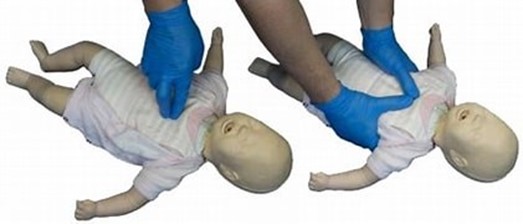A nurse is preparing to begin chest compressions on an infant.
The nurse should perform compressions using which of the following techniques?
Deliver compressions just above the nipple line.
Deliver compressions with the heel of one hand.
Deliver compressions at a depth of 5 cm (2 in).
Deliver compressions at 1/3 the depth of the chest.
The Correct Answer is D
This is the recommended technique for chest compressions on an infant, as it provides adequate blood flow without causing injury12.
Choice A.
Deliver compressions just above the nipple line is incorrect, as this is not the correct location for chest compressions on an infant.
The correct location is below the nipple line, at the center of the chest.
Choice B.
Deliver compressions with the heel of one hand is incorrect, as this is the technique for chest compressions on a child, not an infant. For an infant, two fingers are used instead of one hand13.
Choice C.
Deliver compressions at a depth of 5 cm (2 in) is incorrect, as this is too deep for an infant’s chest.
The correct depth for an infant is about 4 cm (1.5 in) or 1/3 the depth of the
chest12.
Therefore, choice D is the best answer.

Nursing Test Bank
Naxlex Comprehensive Predictor Exams
Related Questions
Correct Answer is A
Explanation
The nurse should place the client on a low-sodium, fluid-restricted diet.
Acute glomerulonephritis is a kidney disease that can cause fluid retention and edema.
A low-sodium diet can help reduce fluid retention and swelling.
Fluid restriction can also help manage fluid balance and prevent further complications.
Choice B is not the best answer because a regular diet with no added salt may still contain high levels of sodium.
Choice C is not the best answer because a low-protein, low-potassium diet may not address the client’s fluid retention and edema.
Choice D is not the best answer because a low-carbohydrate, low-protein diet may not provide adequate nutrition for the client.
Correct Answer is B
Explanation
Pruritus, or itching, of the scalp, is a common symptom of pediculosis capitis, also known as head lice infestation 123.
Choice A is not correct because dry patches on the scalp are not a common symptom of pediculosis capitis 123.
Choice C is not correct because bald patches on the scalp are not a common symptom of pediculosis capitis 123.
Choice D is not correct because blisters on the scalp are not a common symptom of pediculosis capitis 123.
Whether you are a student looking to ace your exams or a practicing nurse seeking to enhance your expertise , our nursing education contents will empower you with the confidence and competence to make a difference in the lives of patients and become a respected leader in the healthcare field.
Visit Naxlex, invest in your future and unlock endless possibilities with our unparalleled nursing education contents today
Report Wrong Answer on the Current Question
Do you disagree with the answer? If yes, what is your expected answer? Explain.
Kindly be descriptive with the issue you are facing.
